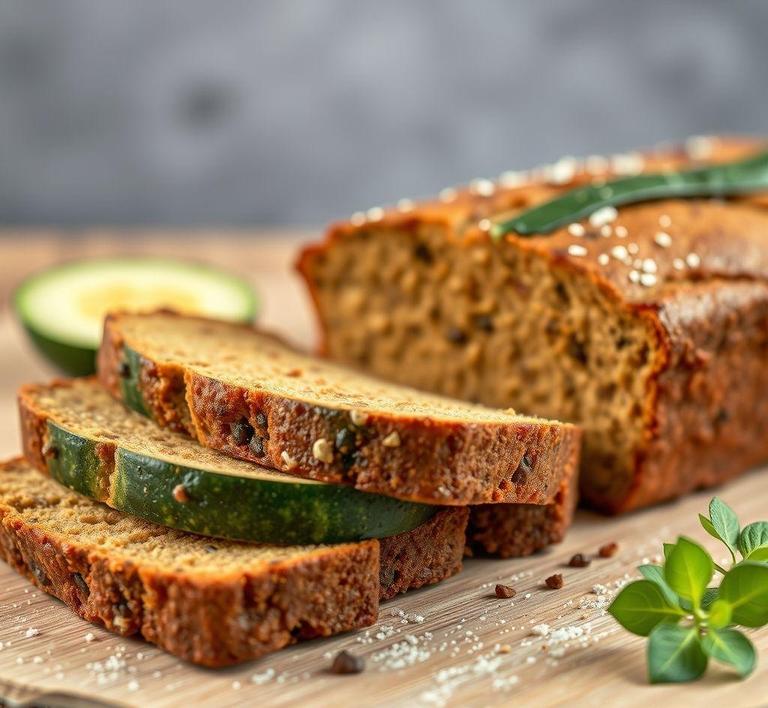If you’ve ever made a big batch of zucchini bread and found yourself with more than you can eat in one sitting, you might be wondering if you can refreeze it to save for later. Refreezing zucchini bread is a practical way to extend its shelf life while keeping it fresh and moist for future enjoyment. In this guide, we’ll walk you through the best practices for freezing and refreezing zucchini bread, including tips on storage, thawing, and ensuring the bread stays as delicious as the day it was baked. Whether you’re dealing with leftover slices or an entire loaf, we’ve got you covered!
Can You Refreeze Zucchini Bread?

Zucchini bread, with its moist crumb and slightly spiced flavor, is a delightful treat that combines the savory depth of zucchini with the sweetness of cinnamon, nutmeg, and sugar. It’s a comfort food that often makes its way into kitchens when zucchinis are in season, and it’s a favorite for those seeking an easy yet delicious baking project.
But what happens if you have leftovers and want to save some for later? Is it possible to refreeze zucchini bread after it’s been thawed? The short answer is yes, you can refreeze zucchini bread, but with some important considerations.
Refreezing, in general, is not always recommended for all foods because it can lead to a loss in texture, flavor, and moisture. With zucchini bread, however, it can be done with care. Zucchini bread has a relatively high moisture content because of the zucchini itself, which helps retain its softness, even after freezing and thawing. As long as you follow the right steps, you can keep that moist, flavorful loaf in good condition for future enjoyment.
How To Refreeze Zucchini Bread?
If you’re planning on refreezing zucchini bread, there are some important steps to ensure it maintains its quality. Here’s a detailed guide on how to refreeze it without sacrificing too much of its deliciousness:
- Cool the Bread Completely: First and foremost, before refreezing your zucchini bread, make sure it is completely cool. If you try to freeze it while still warm, condensation can form, leading to ice crystals that will affect the texture of the bread once thawed. A cool loaf will help retain the right amount of moisture during freezing.
- Slice the Bread (Optional): If you don’t want to freeze the entire loaf, consider slicing the bread into individual portions. This will allow you to defrost only what you need, preventing the need to refreeze multiple times, which can lead to quality degradation. Slicing the bread also helps it freeze and thaw more quickly.
- Wrap It Properly: The next step is crucial. Wrap the bread tightly in plastic wrap or aluminum foil. Ensure that there’s no exposed surface area, as air can lead to freezer burn. For extra protection, you can place the wrapped loaf or slices into an airtight freezer bag or container. Squeeze out as much air as possible to prevent freezer burn and maintain the bread’s texture.
- Label and Date: It’s always a good idea to label your frozen zucchini bread with the date. This way, you’ll know how long it’s been in the freezer. Zucchini bread will keep in the freezer for about 2 to 3 months before its flavor and texture start to decline.
- Freeze It Quickly: After wrapping, place the bread in the coldest part of your freezer to freeze it as quickly as possible. The quicker it freezes, the better it will maintain its texture and flavor when you thaw it later.
Quality Impact
While zucchini bread can be refrozen, it’s important to consider the potential impacts on quality. Refreezing can alter both the texture and flavor of the bread, but zucchini bread tends to handle the process a little better than other baked goods. Here’s how:
- Texture: Freezing and thawing can affect the texture of zucchini bread, making it slightly soggier or denser than when it was freshly baked. This is primarily because of the moisture content in the zucchini. When frozen, some of the water in the bread forms ice crystals, which can cause the structure to break down slightly when the bread is thawed and refrozen. While zucchini bread retains more moisture than many other baked goods, you may notice a slight change in the crumb’s lightness or softness after refreezing.
- Flavor: The flavor of zucchini bread can be impacted by the refreezing process as well. Freezing preserves the flavor, but the delicate spices like cinnamon and nutmeg may become less pronounced after multiple freezes. Also, the overall sweetness may diminish slightly as the bread’s moisture is altered. However, if the bread was well-wrapped and frozen promptly, these changes tend to be minimal.
- Moisture Loss: As mentioned, zucchini bread is quite moist, but with repeated freezing and thawing, the bread could lose some of its original moisture. This may result in a slightly drier loaf after refreezing. Using techniques like ensuring the bread is tightly wrapped and using an airtight freezer bag can help mitigate this problem, but it’s something to be mindful of.
Refreezing zucchini bread is possible, but it’s not without its drawbacks. If you take the proper steps-cooling it completely, wrapping it well, and ensuring it’s stored correctly-you can preserve the integrity of the bread, even if it’s not quite as fresh as the first time around. While there might be some slight changes in texture and flavor, zucchini bread tends to handle freezing better than many other baked goods due to its high moisture content.
That said, the best practice is to avoid refreezing if possible, as each freeze-thaw cycle can impact the overall quality of the bread. If you find yourself needing to refreeze zucchini bread often, it might be a good idea to start baking in smaller batches so you can enjoy it fresh without having to worry about storing and refreezing. Nonetheless, when done correctly, refrozen zucchini bread can still be a delightful treat for future snacking or meals!
Is It Safe To Refreeze Zucchini Bread?
Zucchini bread, like many baked goods, can be a real treat. But when it comes to freezing and refreezing it, there are a few key points to consider to ensure it remains safe and delicious. Refreezing zucchini bread is generally safe, but it depends on how the bread was initially frozen, how it was handled during storage, and how long it has been sitting in your freezer.
Zucchini bread, made with a moist batter, can hold up well in the freezer. The cooling and freezing process helps preserve its texture and flavor for months. However, refreezing it can sometimes affect the bread’s quality. Each time the bread is thawed and refrozen, moisture tends to leach out, which can result in a soggy texture when it’s reheated. This is especially true if the bread was not cooled properly or was exposed to air during the freezing process.
If the zucchini bread has been frozen and thawed properly, and if it hasn’t sat in the fridge for too long, refreezing it once more is unlikely to pose a significant health risk. The key to keeping it safe is ensuring that the bread is not left at room temperature for extended periods, which could encourage bacterial growth. Always make sure the bread is tightly sealed and wrapped well before freezing to maintain its safety and freshness.
Signs That Zucchini Bread Should Not Be Refrozen
Even though refreezing zucchini bread is generally safe, there are a few red flags to watch out for that indicate the bread should not be refrozen. These include:
- Visible Mold: If you notice any mold on the bread, it’s a clear sign that it’s not safe to eat, and definitely not safe to refreeze. Mold can grow on any part of the bread that was exposed to air or moisture during freezing or thawing.
- Off Smell or Taste: If the zucchini bread has an unpleasant or sour smell, it could indicate that the bread has gone bad. This is particularly common if the bread has been left out for too long after thawing, giving bacteria or yeast a chance to grow.
- Soggy or Watery Texture: After thawing, zucchini bread should still hold its shape. If the bread appears overly soggy or watery, it may have lost too much moisture during the freezing process. When refrozen, the bread will likely become mushy and lose its original texture, making it unappetizing.
- Cracks or Dryness: Excessive cracks, dryness, or crumbly texture can also be signs that the bread has been frozen and thawed too many times. Refreezing this type of bread could result in a significantly degraded product.
- Freezer Burn: If the bread has been improperly wrapped or sealed before freezing, you may notice patches of discolored, dry spots. These are signs of freezer burn, where the moisture in the bread evaporates and causes a deterioration of both flavor and texture. If the zucchini bread has significant freezer burn, it’s best to avoid refreezing it.
Common Refreezing Mistakes
When it comes to freezing and refreezing zucchini bread, people often make a few mistakes that can affect the bread’s taste, texture, and safety. Here are some of the most common pitfalls:
- Improper Cooling Before Freezing: One of the most important steps before freezing zucchini bread is ensuring it has cooled completely. If you freeze the bread while it’s still warm, moisture can become trapped inside, leading to a soggy loaf when thawed. Always allow the bread to cool completely to room temperature before freezing.
- Not Wrapping Properly: Zucchini bread can easily dry out in the freezer if it isn’t sealed properly. Using plastic wrap or freezer-safe bags is essential to keeping the moisture in and protecting the bread from freezer burn. Failing to wrap the bread tightly or using improper materials, such as regular cling film instead of freezer wrap, can result in the loss of flavor and texture.
- Thawing on the Counter Too Long: If you leave your zucchini bread out on the counter to thaw for too long, especially in warm conditions, bacteria can start to grow. Thawing bread in the fridge is the safest option, as it keeps the bread at a stable temperature while it defrosts. Leaving it out at room temperature for extended periods can lead to food safety issues, even if you intend to refreeze it.
- Freezing Multiple Times: Each time zucchini bread is frozen and thawed, the moisture content decreases and the bread becomes more prone to losing its structure. Refreezing multiple times isn’t recommended. It’s best to only freeze and thaw zucchini bread once to preserve the bread’s freshness.
- Freezing Whole Loaves: Sometimes freezing a whole loaf of zucchini bread seems convenient, but this can make it difficult to defrost individual slices without losing quality. It’s better to slice the bread before freezing it, so you can remove just the amount you need without having to thaw and refreeze the entire loaf.
Tips And Tricks
If you want to make sure your zucchini bread is refrozen successfully, here are some tips and tricks to maximize both its taste and texture:
- Slice Before Freezing: By slicing your zucchini bread before freezing, you can take out individual pieces as needed without needing to thaw the entire loaf. This also helps to prevent the bread from becoming soggy or mushy from thawing and refreezing repeatedly.
- Use Parchment Paper or Wax Paper: When wrapping your bread, you can layer it in parchment or wax paper before sealing it in plastic wrap or a freezer bag. This extra layer provides more protection against moisture loss, which is especially helpful if you plan to store the bread for several weeks.
- Flash Freeze First: If you have a lot of zucchini bread to freeze, try flash freezing slices or small loaves first. Lay them out on a baking sheet in a single layer and freeze for 2-3 hours. Once frozen, transfer the bread to an airtight container or freezer bag. This prevents the slices from sticking together, so you can easily grab a slice whenever you want.
- Label Your Freezer Bags: Don’t forget to label the freezer bags with the date you froze the bread. Zucchini bread is best consumed within 3 months of freezing, so keeping track of how long it’s been stored ensures that you don’t keep it for too long.
- Thaw Slowly in the Fridge: To preserve the bread’s texture, always thaw it in the refrigerator. This ensures a slow, even defrost that prevents excess moisture from being released all at once, which can make the bread soggy. If you’re in a hurry, you can warm the slices in the microwave, but make sure not to overdo it, as this can dry the bread out.
Conclusion
Refreezing zucchini bread can be a convenient way to preserve your delicious homemade loaf, but it’s important to approach it with care. The safety of refreezing zucchini bread depends on how well it was frozen in the first place and how it has been handled during storage. Always ensure that the bread has been properly cooled, wrapped, and stored before freezing to maintain its safety and quality.
While it’s generally safe to refreeze zucchini bread, be mindful of the potential effects on texture and taste. Over-freezing or improperly storing the bread can result in a soggy, dry, or less flavorful loaf. To make the most of your zucchini bread, slice it before freezing, avoid refreezing more than once, and always thaw slowly in the fridge.

